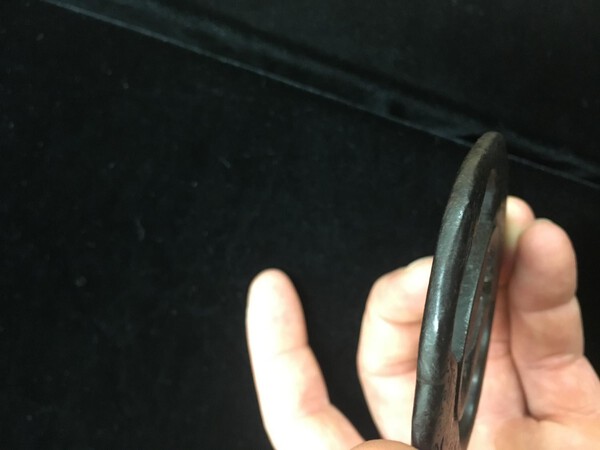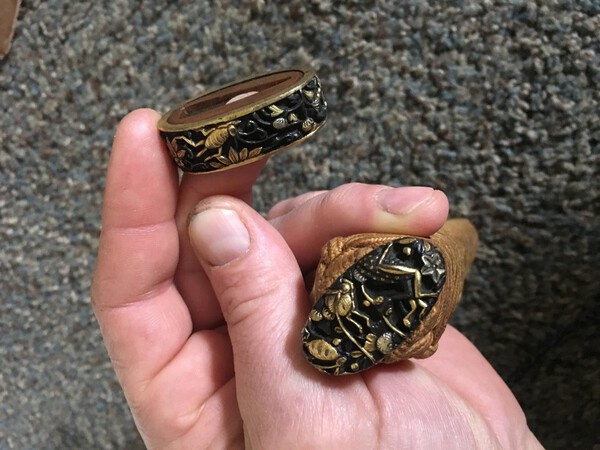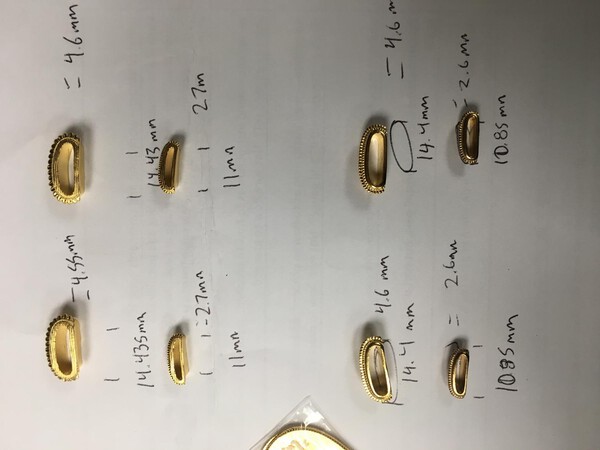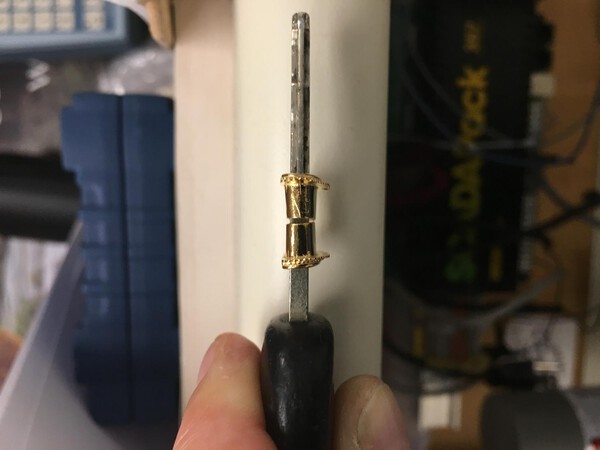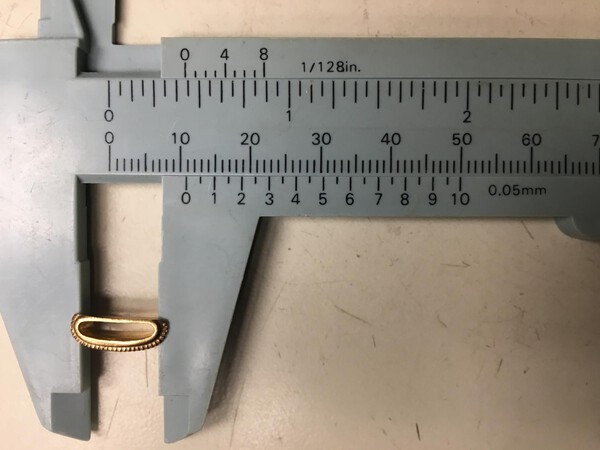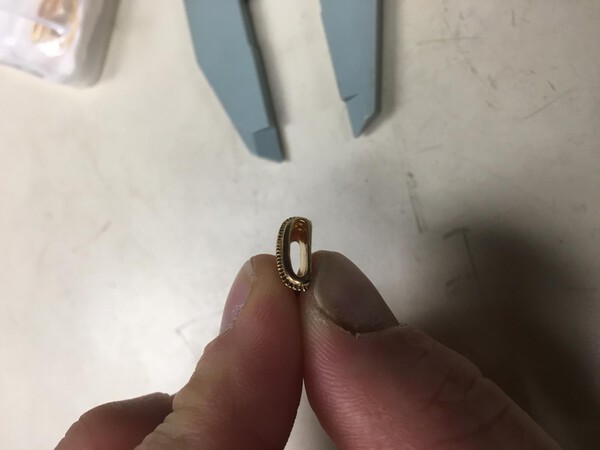-
Posts
456 -
Joined
-
Last visited
-
Days Won
3
Content Type
Profiles
Forums
Events
Store
Downloads
Gallery
Everything posted by ggil
-
please remove my comment.
-
The seller takes non-flattering pics. The spider webbing are surface corrosion that are crawling along the surface, it’s just a surface effect. when there is active rust it acts like a catalyst and drives rust on the surface that spiderwebs our and ruins the surface finish. Ruining the finish allows more surface area and so corrosion will tend to set in faster, but the white spiderwebbing our from an opening or active rust is typical, it’s just this seller takes too honest photos (relatively speaking) and shows cloudy spider-webbing all the time. I’ve purchased a blade from them and it looked way worse in their photos. In hand the white webs will actually look black/dark. The seller’s lighting typically shows flaws well, which is actually a decent thing to do. Tho area of white (looks like hadori) in between the ?active rust hole? And the spider webbing is probably evidence of someone going to town and trying to remove the rust at some point.
-
I would say the first is higher quality, and then defer to the experts to school us on technique! my guess is the "soten" piece has no inlay but plate guilded (?hira zogan?).
-
I would love a chisel like that. maybe they would help you find a suitable replacement even if it means a ‘one-off’ sale for them??? if they do please let me know the price as I just upgraded from a harbor freight chisel set, but still have no curved chisel like that! No knuckle dragging!
-
You need to match your Fuchi to the existing saya size or actually just a hair smaller, for it to look right. If you want to keep the saya. The fuchi dictates the saya width, and the tsuka width at least. after that then you are right back to Jean left off. Good luck and hope to see your results. I’m curious what the price would be?
-
Just took these pics at the Christmas meeting. the owner of these 2 pieces knows the school or probably has NBTHK origami if you want me to look that up. I should’ve paid attention. One shows more linear bones and one is more random. Totally different forging, I guess.
-
Shark skin or lizzard skin I think. Pointy scale ends not as rounded like a snake. The blade could be inspected for hada (I see none or muji, but the pics aren’t like looking at it the sun with eyes, for sure), or the Harmon for nie (large/visible hardened crystals near the Hamon), as these things are unlikely or impossible in highly refined non-tamahagane. “Traditionally” means tamahagane and water quench. With as many non-traditionally made blades from the era, this blade isn’t too likely to be traditionally made. the blade being in real Japanese polish would help to study its properties. The wider (the mune-saki at the kissaki gets wider a bit... someone please help me with the terminology) kissaki is nice and is a point that contradicts the above, and I hope the picture is causing the taper to ‘“look” poorly shaped at the kissaki. If the taper does actually make a steep observable change just a couple inches below the kissaki (as the lighting makes it seem), then that fact would again support the conjecture that thisblade is non-traditionally made, which it likely is.
-
I always assumed: more “fudge factor” with more seppa. I mean that you don’t have to spend as much time making the tsuka perfect, and you just have to add more or less seppa to fill in the over-gapped (fudged up) tsuka. I see this As ‘modernization’, or making greater supply by cutting small corners. Similar to the use of plates to stamp out blades and not forge them. I think more seppa the less functional, as the blade would bear more stress due to less support of the nakago. I imagine it became a military standard which had to be adhered to eventually, but I bet the old school smiths didn’t like multiple seppa. Sorry for the conjecture, if that is all it is.
-
Looks like a regular wakizashi. Boys day blade would be smaller motohaba. Do I need more caffeine?
-
I (WAG probably dead-wrong) guess the menuki were by the same hand, but unsigned so we will never know who. Pretty flashy late edo “mino” work. With the nice tsuka wrapping it makes a great display. the quality is relatively low though, I mean compared to what subtleties in Japanese fine art are out there. Most serious collectors consider this type of stuff trite and not too desirable, but that isn't to say that they cant command a high price. I got this tsuka as a koshirae, where the real value is in the saya lacquer job. uniform sizes of copper filings inlaid into the clearcoat. the shiney red/gold copper and the gold/brown tsuka ito are stunning together, but again late and over flashy lacking the subtleties once prized and sought by a more discerning market. Also the tsuba was very old but kinda poorly cut. the shitodome on the saya are really nice though. I think it was a great deal overall for just over $400 on ebay for the entire package. most of the FK I see of this theme, are worse, but it only takes one look at some REAL master work to see that this stuff is poor and very late.
-
you get what you pay for also. don’t be tempted to use an amateur if you don’t want the blade bastardized! The fittings should entice and really show off the blade in an elegant way. I’m a hobby koshirae/shirisaya maker. My work pretty much sucks! My work will probably always be sub-par from a real trained koshirae/saya-shi. Also, the amateurs probably make s**t saya and maybe the blade rusts away due to touching the wood inside.
-
Thanks for sharing. Never heard of a tsuba removal tool. I heard of tsuka removal tool, Fred Lohman has that market cornered: $30 for wood mallet and the funky shaped wedge thing, and decently crafted, from the pics and my experience of other stuff he gets crafted in PI (his horn parts are great, for example)
-
Should be kept just for the link to the Usagiya sword shop. Fun reading there for sure, thanks Marius. Steve, How is the grinding done? I bet: by hand filing, sort of like a polisher (a pattern of patches to keep a constant depth), and not bearing into it constantly but being well knowledgeable about how excessive heat will free those molecules up and ruin it. Fa’a Samoa
-
Very interesting experiment results. Makes me wonder how accurate the books are, when the hamon (a major kantei point) can change over time through polishes. Maybe the amount of metal removed here on one side was more significant than a blade would typically see before being fatally tired, not sure. The price seems good to me also, or cheap if you consider the rarity and implications of the results.
-
Could be a hagire, as this point would experience a significant amount of stress in actually use. It would be pretty easy for a polisher to conceal one side of it, although why would only one side be concealed? Makes no sense so maybe just a forge flaw
-
the foundations are perfectly nice for a display koshirae (gotta make a tsunagi, which would actually be a lot of fun), so I maybe went too hard on it. If it came for not too much cash. Plus I’ve heard there are less koshirae than blades, so these are good to preserve (sun will hasten the aging of the saya lacquer, for example). Sorry to kinda put it down, without mentioning it’s good qualities (I’ve done that before), and maybe risk premature damage to useful and potentially culturally relatively valuable artifacts.
-
Most interesting part to me is the saya, but maybe because I like sayas a lot. The rest is either low quality or had rough treatment, And these tend to concur. studying poor blades ruins your eyes, and tosugo isn’t excepted from that old saying.
-
Mr. Hallam San turned me on to this place (Namikawa Heibei) for sourcing urushi (I think), but I purchased shitodome and was so happy with the product that I wanted to share with you all. I purchased both quality offerings they had (reg and top quality), for both kashira and kurigata. While I was asked not to discuss the price (Japanese can be so considerate of others, possibly resellers, is all), I was told that they would be happy for me to discuss the quality. The fisrt thing was that the ?barrel? sizes are all almost perfectly matched, and there were no rough spots on the inner surface to wear the silk. The top quality ones are silver base. the kashira Shitodome all fit almost perfectly in the old kashira I am working with. The top quality kurigata ones are built to have a slight taper, as to fit nicely flat to the kurigata. The ordering is via email or fax, and they accept PayPal. They had the parts to me within a week of ordering, also ridiculously fast. I ordered (2) 100gr tubes urushi, a susudake piece that was much larger than I expected (for the price - I’m tiptoeing here), a top quality seppa (not thrilled but nice enough, should make my own with these), and the Shitodome; shipping was 2000 yen. They mostly are sellers of sword polishing equipment (don’t worry, no plans going there), and have been in operation for over 150 years. They will send pictures via email and did for me without me asking.
-
I’d keep 1a, 3, 13, 19, and 21 (my favorite of the group). Maybe the ocean theme diasho but I would keep them to mount not to study. if any of these you have taken the time to get papers with them I would keep those tsuba, as you have a time and effort put into them and they are verified (well somewhat so) of a particular school etc, so most useful for study.
-
I just set up a little aquarium for the 3 year old, notable minding Japanese art aesthetic such as the use of open space, and function and form of lots of plants and various rocks for the fish to hide in. I even added a sitting smiling Buddha, and think it all looks lovely. Only issue is the 12 year old had to have a perfectly black fish, and this fish insists on killing every animal he gets near. He is currently working on murdering the snail. The 3 year old pleaded to me with tears after he killed her last fish “Can’t we just kill him?” Whenever we bring up the fact that the black fish is a killer, the 3 year old goes around in a hushed voice trying to convince us to kill him (or open the lid and let the cat do it).
-
Horses for courses: My collection is put away that way I am free to turn the house into a steam bath if the kids are coming down with a sinus issues. It does seem like being able to study a tray full of a specific school would be a good way to become extremely familiar with that school. Sounds like maybe some members, who can afford travel, need to visit. I have a desire to visit Britain, for instance; however Now I have to wait until the baby gets to be around five or so, which will be in about five years. I must take a rain check on inviting myself to visit .
-
The fittings are nicely done. Maybe some cloud designs on the saya but can’t see too well. Personally I think a re-wrap wouldn’t be out of the question. You could use girls hair ties (I have daughters so I am adept at hair tie use) keep what is left together. Anybody know who could re-wrap this or what they charge? Sometimes the tsuka is damaged during a re-wrap. Hopefully the tsukamakishi wouldn’t wrap it “for battle” if the tsuka core is deteriorated badly or too old. Probably they would want to make a new tsuka.
-
The seam is natural and nothing needs be done to it. It’s made it 100 years so far. Handle it with gloves to keep your juices off it, it will last a hundred more probably. I keep mine inside a safe with desiccant inside. You put something on it you will probably regret it, and around here you don’t want to be known as the tsuka greaser. Or worse: the grip Oiler; The handle fluffer. Just kidding, but seriously if you want it restored so it preserves better then maybe consulting a museum or privately contacting a professional would be best. If I was a professional I wouldn’t publish methods on a public forum for reasons.
-
As far as I know, nie (large visible hard steel structures in and near the Hamon) are not found on oil quenched, one sure fire way you know you have water quenched. Someone needs to invent a non destructive way to test hardness, to really get an understanding of the hardness near the surface. This way you could measure the differential hardness across the ji. That would tell us more than our eyes. to me, it isn’t just how hard the edge is but how soft the balance is that makes nihonto special. It has some give to it not just a brittle thing. Personally I don’t consider showato as functional as nihonto generally speaking, because of many reasons. I doubt the level of hardness differentiation, and the ha hardness itself. The farther back one goes the more likely I think a nihonto destroys a showato in functionality, generally. Plus, as far as speed goes, many Koto works have been polished downtown thepoint that they are very fast and light. Maybe against armor a bad thing, but in plain clothes I’d rather have a katana weighing 700g over a 900g blade. Plus as much of the damage has been near the tip (ideal strike area), the koto works tend to have a greater taper and hence feel even lighter and take less energy to swing (they are faster). I guess functionality is a matter of the situation at hand, really, and a showato may be more functional than nihonto in the right circumstances. Sorry I can help much. Maybe there are some microscope pictures of water quenched nioi VS oil quenched, and maybe there is a difference. I like Hamfish’s point about dark spots, I have seen that in showato also.
-
Relisted at $170. Seller certainly proud of the mimi as 1/2 the pictures show the tsuba on It’s side, so not showing much more than what? I think those are forging laminations. I think the seller probably knows it, on some level at least.









